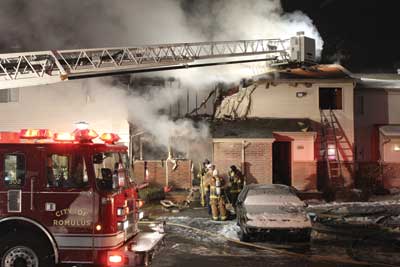By John F. “Skip” Coleman, Technical Editor
I was involved in training for the majority of my career. As a lieutenant, I was a training officer for a recruit class in 1984. I was promoted to captain while on that assignment and went back for another class. I was a battalion chief assigned to training and was in charge of overseeing training as a deputy chief. During the majority of these times, the “computer” was a small part of the job. In fact, the Internet was nonexistent until the latter part of my career as a deputy chief.
We now have become dependent on the computer and the Internet. I can’t believe how much easier my task would have been if I had those tools back then. To have the availability of the video and photos, the fire reports, and investigations must be invaluable. It is said, “The essence of training is to allow error without consequence.” Fire simulation programs make it possible to discuss strategy and tactics and coach and mentor without the possibility of getting injured or worse. This does not replace actual fireground training, but prior coaching, teaching, and mentoring can make for a safer fireground.
Roundtable question: Has the computer taken over as a key training tool for your department? To answer, go to fireengineering.com/roundtable.html.
 |
| ● PHOTO OF THE DAY: Fire broke out at an occupied apartment building in Van Buren Township, Michigan. Although there was extensive damage to the building, the fire was contained to only four units. Fire crews from three communities were on scene for at least three hours containing the fire. (Photo by Andrew Lundell.) See more photos at http://emberly.fireengineering.com/photo-of-the-day.html. Send your Photo of the Day submissions to Peter Prochilo (peterp@pennwell.com). |
WEBCASTS
Monthly Webcasts feature the best of Fire Engineering authors and FDIC speakers. On Thursday, April 18, Fire Protection Specialist Frederick Bachner, New York State Office of Fire Prevention & Control, will present “Fire Service Training Needs: A Moving Target.” The focus is on conducting an objective training needs analysis for the training officer, which benefits firefighters and the department. Webcasts are free, but you must register!
FIRE LIFE
Read Anne Gagliano’s gripping multipart series “Keep It in Perspective” on the Mary Pang Warehouse Fire and how it affected the Seattle Fire Department members and their families in her column “What Every Firefighter’s Spouse Should Know,” only at www.firelife.com.
FEATURED ARTICLES
Mark van Der Feyst, a 14-year veteran of the fire service and a member of the Woodstock (Ontario, Canada) Fire Department, writes in “Live-Fire Training: Much Preparation for Safety”: “The lack of exposure and continual practice of our bread-and-butter operations is breeding a generation of firefighters who are deficient in structural firefighting, a high-risk event that occurs with lower and lower frequency. This is a dangerous time for us, especially if we are rusty with our skills of fighting fire.” (http://bit.ly/W8Qoo9)
Sam Villeni III, a lieutenant with the Montgomery County (MD) Fire and Rescue Service, and Frank Ricci, a lieutenant in the New Haven (CT) Fire Department, write in “Elevator Rescue Lessons Learned”: “Extracting occupants from a stalled elevator car makes for a complicated rescue. Finding ways to think outside the box is one of the keys to minimizing the risk.” (http://bit.ly/Yt1v7p)
George H. Potter, a fire protection specialist in Spain, writes in “High Death-Toll Tragedies: What Can and Should Be Learned”: “Since 1970, there have been at least 80 major fires around the world that have caused 20 or more fatalities, plus 14 deadly incidents in which fire was not involved. The great majority of these tragedies occurred in places where large numbers of persons congregated, often surpassing the established capacities.” (http://bit.ly/WmZPL1)
Jeremy Mitchell, a firefighter with the Champaign (IL) Fire Department, writes in “Selecting Firefighter Candidates: Taking the Longer View”: “In the course of our hiring process, we’ve changed a few things that have caused some members of our organization to question what we do and how we do it. There is some worry that by changing our hiring standards we are losing our ability to bring aboard people who fit the traditional definition of ‘firefighter.’ ” (http://bit.ly/YSEhYt)
COMMUNITY MEMBER OF THE MONTH |
||
|
Name: James Day. Department: Atlanta (GA) Fire Rescue. Title/rank: battalion chief. Years of public service: 33. Agency structure: paid department. Top issues in your department: accreditation, performance management, emergency management. Topics you provide training for: accreditation, performance management. Professional qualifications: associate degree in fire science, bachelor’s degree in public policy, enrolled in EFO. |
 |
|
Fire Engineering Archives

